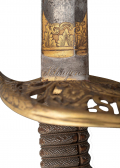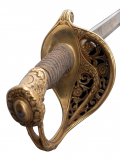site search
online catalog
IMPRESSIVE CASED PRESENTATION GOLD WASHED, DAMASCUS BLADE SWORD OF WILLIAM WOOD, CAPTAIN, MAJOR AND LT. COLONEL 9th NYHA WITH BELT AND SASH- WOUNDED BY A CANISTER SHOT AT SAILOR’S CREEK!

$9,500.00 SOLD
Quantity Available: None
Item Code: 1052-1136
This is a striking presentation sword with the upper mount engraved in a mix of block letters, Old English, and script, with flourishes: PRESENTED TO / Capt. Wm Wood / BY/ his fellow Citizens of Butler, NY/Sept. 1862. The sword, impressive on its own, is accompanied by the officer’s sword belt and sash, and is cased in a fine walnut presentation case with a dark blue velvet fitted interior. Wood fought at Cedar Creek, the climactic battle in the Shenandoah, in the trenches at Petersburg, and in April 1865 in the final assault on city, and the Battle of Sailor’s Creek. In the assault on Petersburg, he was praised for his conduct: “Major William Wood performed his duty nobly in urging his men forward to the assault, and after carrying the works, in turning the enemy’s guns upon them with telling effect.” And, in the fighting at Saylor’s Creek, “Major William Wood, while leading his battalion in charge, received a dangerous wound from a canister shot in the face.”
The sword is a staff and field pattern with floating “U.S.” worked into the floral openwork guard. The pommel, including the pommel cap, knuckle bow and guard are deeply cast and chased with floral motifs, including acanthus leaves enfolding the upper part of the knucklebow, nested bell flowers along the inside of the branches of the guard, a narrow, incised border on the inside of the counterguard, and quillon disk incised with scrolling lines. The grip is sharkskin, light gray with some minor wear and a shrinkage gap along the seam, bound with a single strand of twisted brass wire. The brass has a muted gold tone with some gilt evident in recesses.
The blade is very good, with good edge and point, showing a soft silver color with much of the gold wash still there and with the watery Damascus patterning of the blade fully visible and as are the etched and gold washed panels extending about half way up the fuller with the Damascus patterning continuing visible above that with just a few thin gray stains. The obverse has “Solingen” in script on the ricasso followed by dense floral scrolls above and below a central panel showing an American eagle flourishing an E Pluribus Unum ribbon scroll overhead, all set in sunburst glory with rays and lightning bolts jutting out from top and bottom. From the top of the upper foliate section a gilt washed globe emerges, topped by a Liberty Cap on a pole.
The reverse is similarly impressive, with a gold washed palmette and floral scrolls leading up to a gold washed central panel framed top and bottom by a similar arc of clouds and sunburst glory of rays and jagged lightning bolts, showing at center a US shield, with US in the canton and vertical stripes, with a wreath below. From behind the shield emerge two flags on spearpoint staffs with knotted flag cords, one of the flags clearly showing stripes, and with a tall halberd standing in the middle, topped by a Liberty Cap. Scrolling floral elements complete the panel, topped by an eagle or perhaps phoenix, with leaf and berry branch in its beak, shown emerging from the floral scrolls, just as does the globe on the obverse.
The scabbard is black leather with gilt brass mounts. The leather has good color, but shows crazing and flaking with some weakness from age, but the mounts more than make up for it. The upper mount is solid above the carrying ring band, with the presentation engraved on the obverse. Below the solid portion and ring band, the mount extends in a rectangular frame with cast and chased open floral designs on both sides, with heavy floral border at top and on the ring band. The middle mount is a similar openwork rectangle with the carrying ring simply mounted at top center. The boot style drag is plain, but topped with a third openwork floral rectangle. The gilt mounts match the hilt, with the upper mount showing traces of gilt, but the drag with its decorative mount showing a lighter from wear.
Both the sword belt and sash show signs of wear, but present very nicely. The belt plate is the regulation 1851 pattern rectangular eagle sword belt plate, with nicely detailed arms of the US at center. The belt shows some wear to folded black leather and the sewn borders, but has the adjusting buckle and square brass loops for the sword slings in place. The belt was provided with two sets of sword slings that are loose in the case. One set is folded leather with stitched borders, matching the belt, that adjust by horseshoe buckles, attach to the belt loops with simple studs and have snap hooks. One of these, the shorter, is missing the upper end. The other set is flashier, consisting of gilt brass links in a ladder chain, with simple hook at the top and snap hook at the bottom. The studs for fastening the leather set are in the box. The sash is the regulation crimson silk with turk’s head knots and tassels. The sash is solid, shows some slight fading from use, and some wear to the upper portions of the turk’s head with some loose threads. The case itself is very nice, with good color and finish. It is lined in dark blue velvet top and bottom, with some wear to the dividers, and has a key lock and two sliding latches.
William Wood enrolled in the army at age 32 in Auburn, N.Y., on Aug. 24, 1862. He came from the small town of Butler in Wayne County, graduated Union College in Schenectady, in 1856, and a year after that from Albany Law School. After practicing law for two years, he returned to Butler where he took up farming, perhaps in response to the death of his father, a farmer there, in 1860. He signed up in response to Lincoln’s call for 300,000 more troops in July 1862 and was instrumental in raising company of volunteers that eventually became Company G of the ”Second Auburn Regiment” or the “Wayne County Regiment,” but mustered in officially as the 138th New York Volunteer Infantry on Sept. 8 and 9, 1862, for three years’ service, with Wood elected Captain of Company G, commissioned officially on Sept. 10 with rank from August 24.
The presentation is dated simply September 1862, and likely took place prior to Sept. 12, when the regiment left the state for Washington, where it was posted to the city’s defenses. The campaign of Second Bull Run and Antietam campaigns had raised concern about the city’s safety and regiment remained there, finally being converted to a regiment of heavy artillery, fitting its duty in the forts surrounding the city. This meant its eventual expansion from ten to twelve companies, artillery practice in addition to infantry drill, redesignation as the 9th New York Heavy Artillery in December, and assignment to various forts by company and by battalion, where their duties including construction of roads and fortifications under the supervision of Engineer officers.
In Fall 1863 Wood’s company was in the regiment’s battalion assigned to help construct Fort Foote, situated six miles below Washington on a bluff overlooking the river, eventually 500 feet long with 20-foot thick earthen walls, and armed with two 15-inch Rodman guns, four 200-pounder and six 30-pounder Parrott Rifles. The battalion arrived on August 14, 1863, and remained for nine-months, when they were called into the field in July 1864 for Grant’s drive against Richmond and Petersburg. The regiment was assigned to the 6th Corps, but once again served by battalion, each of which was stronger than most regiments by that time, with the battalion containing Company G assigned to the corps artillery brigade, where their duties once more involved construction of field works and gun positions as the armies repeatedly dug in.
When the 6th Corps was sent in pursuit of Early and marched to the Shenandoah Valley, Wood’s battalion returned to the Washington fortifications until called to the front in time to see action at Cedar Creek, where Wood, commissioned a Major on Sept. 28, with rank from June 28, commanded the battalion, consisting of Companies G, K, I, and D, and designated the 1st Battalion, in the fighting of October 19, in which the regiment lost 3 officers and 40 enlisted men killed, another 23 enlisted men mortally wounded, and 5 officers and 137 enlisted men wounded.
The regiment, including Wood’s battalion, returned to siege duty and trench fighting on the Petersburg front in early December where Wood was in command of five companies posted at Fort Wadsworth in the Petersburg lines near the Weldon Railroad. He was commissioned Lieutenant Colonel on Dec. 27, with rank from Nov. 28, though not mustered at the time, an oversight corrected by the state only in 1904, officially giving him that rank until mustering out on July 6, 1865, though apparently with a brevet to that rank in between. He saw his last fighting in close succession April, 1865, taking part in the final assault on Petersburg on April 2, where he was commended for leading his men in the charge and turning captured guns on the enemy, and lastly at Sailor’s Creek, where he was wounded by a canister shot according to the regimental history.
Wood was discharged in July 1865 and returned to farming in New York, with a stint in the state legislature. He passed away in 1903 and was buried in Butler. [sr][ph:L]
Extra shipping charge required.
~~~~~~~~~~~~~~~~~~~~~~~~~~~~~~~~~~~
THIS ITEM, AS WITH ALL OTHER ITEMS AVAILABLE ON OUR WEB SITE,
MAY BE PURCHASED THROUGH OUR LAYAWAY PROGRAM.
CLICK HERE FOR OUR POLICIES AND TERMS.
THANK YOU!
Inquire About IMPRESSIVE CASED PRESENTATION GOLD WASHED, DAMASCUS BLADE SWORD OF WILLIAM WOOD, CAPTAIN, MAJOR AND LT. COLONEL 9th NYHA WITH BELT AND SASH- WOUNDED BY A CANISTER SHOT AT SAILOR’S CREEK!
For inquiries, please email us at [email protected]
Most Popular
Historical Firearms Stolen From The National Civil War Museum In Harrisburg, Pa »
Theft From Gravesite Of Gen. John Reynolds »
Selection Of Unframed Prints By Don Troiani »
Fine Condition Brass Infantry Bugle Insignia »
Wonderful Condition Original Confederate-Manufactured Kepi For A Drummer Boy Or Child »
featured item
IDENTIFIED CIVIL WAR US NAVY GROUP OF G.W. BROWN, PUBLISHED IN TIME-LIFE AND IN BLUEJACKETS, EX-STAMATELOS COLLECTION AND TEXAS CIVIL WAR MUSEUM
This a very scarce, extensive, identified Civil War U.S. Navy grouping, once in the renowned Stamatelos collection and more recently exhibited in the Texas Civil War Museum. It has also been published several times: most notably in Ron Field’s… (1179-262). Learn More »



























